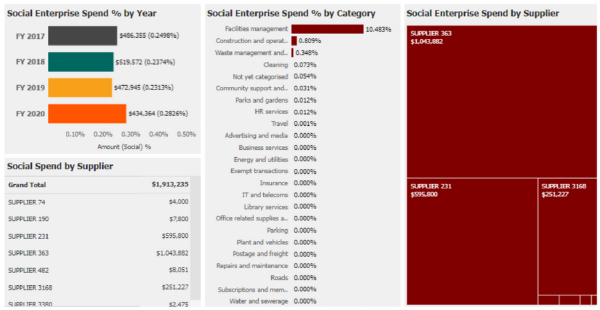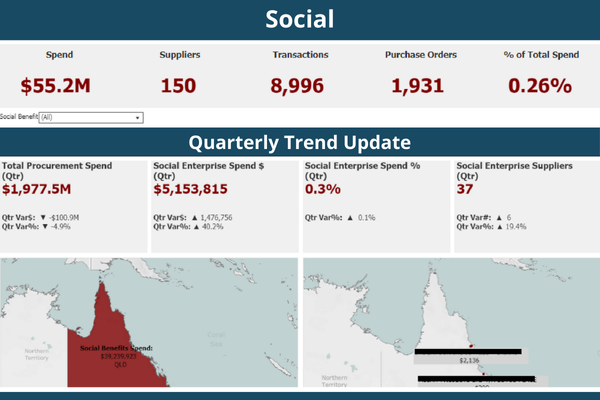Procurement Data Talks - Social Dashboard
By Glen Duff, Director of Procurement and Partnership
Local Buy’s procurement dashboards are part of a full suite of 12 configurable reports available to Queensland councils under Local Buy’s procurement technology and data program. In this extended article, we’ll provide some guidance on what social procurement is and how council can use their Social dashboard to better meet their strategic social procurement objectives.
Firstly, let’s talk compliance.
Compliance with the Local Government Regulation 2012 is critical, even with social procurement. Councils use Local Buy Arrangements to compliantly engage with suppliers (including social) either directly or via a simpler quotation process. This reduces the costs of doing business for council and supplier.
Councils have the ability to contract goods and services without first inviting written quotes or tenders if the contract is entered into under the LGA Arrangement setup by Local Buy. Alternatively, a simpler quotation process to Local Buy suppliers, via Local Buy Arrangements, is all that is required to compliantly procure at any value.
Local Buy has already pre-qualified these suppliers via a comprehensive public tender and evaluation process in accordance with the requirements of The Local Government Regulation 2012. When councils engage via Local Buy Arrangements, suppliers are also subject to already agreed General Terms and Conditions, in addition to any additional Terms and Conditions council may apply throughout the quotation process.
Local Buy Arrangements help Queensland councils to compliantly procure in a way that better meets their objectives, including social and local targets.
What is Social Procurement?
In an era where corporate responsibility and ethical practices are no longer optional but essential, social procurement has emerged as a critical strategy for councils aiming to make a positive impact.
Put simply, social enterprises are social businesses that put people and the planet first, while social procurement refers to the practice of integrating social value into procurement processes. This means that councils not only consider cost, quality, and delivery when purchasing goods and services but also evaluate the social impact of their suppliers.
What outcomes does Social Procurement seek to achieve?
Social Procurement seeks to achieve different outcomes for different councils. Generally, these objectives can include:
- Supporting diverse suppliers including those that are owned by underrepresented groups, including indigenous and other minorities.
- Supporting suppliers that have a defined cultural or environmental purpose consistent with a public or community benefit.
- Supporting local economic development by choosing social suppliers from the local community to stimulate regional growth.
Why identify and support your Social Spend?
There are many advantages to identifying and supporting your social spend, even if you do not have a social procurement policy in place. These include:
-
Drive Positive Change: By identifying and supporting social spend, councils can directly contribute to social and environmental causes. This proactive approach ensures that council operations align with broader societal goals, such as reducing inequality and promoting sustainability.
-
Enhance Council Reputation: Councils with strong social procurement practices often enjoy a boost in reputation. Demonstrating commitment to social responsibility generally meets the expectations of local communities and employees who value ethical practices.
- Improve Supplier Diversity: Supporting a diverse range of suppliers helps level the playing field for businesses that might otherwise face barriers to entry. This can lead to increased innovation, as diverse suppliers often bring unique perspectives and solutions to the table.
- Meet Regulatory Expectations: Many governments are implementing regulations and standards around social procurement. By proactively tracking and supporting social spend, councils can ensure compliance and meet the expectations around increasing social responsibility.
- Build Stronger Community Relationships: Engaging with local and diverse suppliers fosters a sense of community and builds stronger, more resilient relationships, often important in our local council communities. This local engagement can enhance council's understanding of community needs and contribute to its overall social license to operate.

How to track and support Social Spend?
There are some practical steps that council can undertake to explore, develop or mature your social procurement strategy. These include:
-
Establish Clear Goals: Define what social procurement means for your council and set measurable objectives. This might include targets for spending with diverse suppliers or implementing sustainable practices.
- Provide Opportunity: Track your procurement engagement with social enterprises. Providing more social enterprises with more opportunities to win work is often the first step towards increasing the social impact of council.
- User Effective Reporting: Use Local Buy reports to track social spend. These reports will effectively support council in understanding the opportunities to and/or spend via verified social enterprises.
- Engage with Suppliers: Communicate your social procurement goals to your suppliers and encourage them to align with your values. Providing support and resources can help them meet your social criteria.
- Report Progress: Building a social procurement impact will start slow, especially in the regions. Regularly review your social procurement data and report on progress towards your goals. Transparency in your efforts can enhance credibility and demonstrate your commitment to social responsibility.
- Continuous Improvement: Sustainable social procurement is not a one-time effort but an ongoing process. Continuously seek ways to improve your social procurement practices and adapt to emerging trends and expectations.
Key components of the Social Detail report include:
-
Social Summary: Includes the value of social spend, number of (a) social suppliers used (b) transactions and (c) purchase orders and the % spend versus total spend (social and non-social). Procurement teams can use this data to focus their efforts on understanding their holistic social spend, and also that of different social segments i.e. Indigenous.
-
Quarterly Trend Update: The Quarterly Trend Update lets you assess the general trends across total procurement value, social procurement value and % and the number of social enterprises engaged. Quarterly trends let council monitor trends at a granular level.
- Social Enterprise Spend % by Year: The objective for most councils is to slowly increase social procurement spend over time by introducing practical steps to procurement, while still ensuring compliance with The Local Government Regulation 2012. This report shows the % tend of social spend annually, allowing councils to understand progress over time.
- Social Enterprise Spend % by Category: Social spend by category provides a breakdown of social spend at the category level. This provides meaningful insights detailing which categories are being better serviced by social enterprises, and where council can focus their social supplier engagement strategies.
- Social Enterprise Spend by Supplier: By analysing which social suppliers are winning work, councils can better measure their overall social procurement impact and work with other suppliers to better increase their future opportunities.
Local Buy can support council’s objectives, including social.
Many procurement plans include practical steps to support social enterprises, such as (a) providing more procurement opportunities i.e., quotations to social and/or local businesses via Local Buy Arrangements (b) allocating an evaluation criteria % to consider the respondents' social status and impact, and (c) working with social enterprises in the community to better prepare them for responding to business opportunities and doing business with council.
To get started, it is important to track and support councils' social spend. By leveraging these reports, provided under Local Buy’s procurement technology and data program, councils can optimise social spend, improve social supplier opportunity and contribute to the overall strength of council's social license.
Here are some additional tips I like to share for using procurement reports effectively:
-
Do not be afraid of data. It is easy to read these reports and quickly identify opportunities for council. Start off exploring want you can learn.
-
Use a variety of reports to get a complete picture of your procurement performance. Don't rely on just one type of report.
-
Share your reports with the appropriate stakeholders. Make sure that the people who need to see the reports have access to them. Collective thinking can deliver great data results.
- Use your reports to act. Don't just generate reports and then file them away. Use the information in the reports to make improvements to your procurement processes.
If you would like to know more, please get in contact with Glen Duff, Director of Procurement and Partnerships, Local Buy via gduff@localbuy.net.au.
If you would like to gain access to the Procurement Dashboards, fully funded by Local Buy for Queensland councils, please contact our local government technology team via nexgen@localbuy.net.au.

